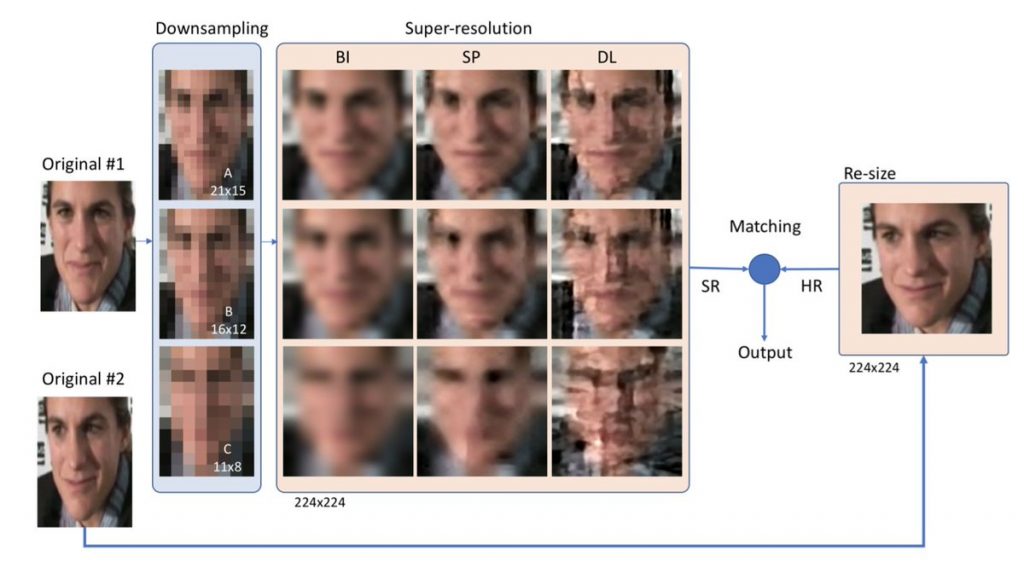We are investigating the frontiers of human and computer vision working not only alone, but also working both in-collaboration recognizing face images.

Frontiers of Face Recognition in Low-Quality Images
The main goal of our project is not only to investigate the frontiers of human and computer vision working alone, but also to investigate how computer vision and human vision can work in-collaboration to recognize face images depending on their low-quality characteristics. Thus, our main hypothesis is that human vision and computer vision in face recognition of low-quality images can mutually benefit from one another. That means, when recognizing low-quality face images i) human vision accuracy can be improved if the face images are enhanced using computer vision algorithms before the humans examine the images; and ii) computer vision accuracy can be increased if we include new models based on human perception.
Face Matching from Teenagers to Young Adults
The project is focused on an important topic of current research in the area of facial recognition. The basic problem is to develop high-accuracy facial recognition for matching images taken in early teenage years, as early as 12 years old, with images taken as young adults, up to middle or late 20’s. Two elements combine to make this particular instance of the face recognition problem quite difficult. i) One element is that a person’s face naturally goes through substantial real changes from early teenage years to middle 20’s. ii) The other element that makes this problem hard is that the initial image is a document image; that is, a face image printed on and identity card. This problem of `Matching ID Document Photos to Selfies’ is a current hot topic in face recognition research.
Low-Quality Face Recognition in the Wild
Although face recognition systems have achieved impressive performance in recent years, the low-resolution face recognition (LRFR) task remains challenging, especially when the LR faces are captured under non-ideal conditions, as is common in surveillance-based applications. Faces captured in such conditions are often contaminated by blur, nonuniform lighting, and nonfrontal face pose. In this project, we are aiming at analyzing face recognition techniques using data captured under low-quality conditions in the wild. The performance gap between general unconstrained face recognition and face recognition in surveillance videos is shown and new algorithms are designed to tackle this specific problem.
Face Recognition in Low-Quality Images using Adaptive Sparse Representations, Heinsohn, D.; Villalobos, E.; Prieto, L.; and Mery, D. Image and Vision Computing. 2019
On Low-Resolution Face Recognition in the Wild: Comparisons and New Techniques. Li, P.; Prieto, L.; Mery, D.; and Flynn, P. IEEE Transactions on Information, Forensics and Security. 2019.
Student Attendance System in Crowded Classrooms using a Smartphone Camera. Mery, D.; Mackenney, I.; and Villalobos, E. IEEE Winter Conference on Applications of Computer Vision (WACV2019).
Recognition of Faces and Facial Attributes using Accumulative Local Sparse Representations. Mery, D.; and Banerjee, S. IEEE International Conference on Acoustics, Speech, and Signal Processing (ICASSP 2018).
Face Recognition in Low-Quality Images: A Survey. Li, P.; Prieto, L.; Mery, D.; and Flynn, P. arXiv, 2018.
Learning Face Similarity for Re-identification from Real Surveillance Video: A Deep Metric Solution. Li, P.; Flynn, P.; Mery, D.; and Prieto, M. International Joint Conference on Biometrics (IJCB2017).
Face Recognition Using Sparse Fingerprint Classification Algorithm. Larrain, T.; Bernhard, J.; Mery, D.; and Bowyer, K. IEEE Transactions on Information, Forensics and Security, 2017.
On accuracy estimation and comparison of results in biometric research. Mery, D.; Zhao, Y.; and Bowyer, K. IEEE International Conference on Biometrics: Theory, Applications, and Systems (BTAS 2016).
Automatic facial attribute analysis via adaptive sparse representation of random patches. Mery, D.; and Bowyer, K. Pattern Recognition Letters, 2015.